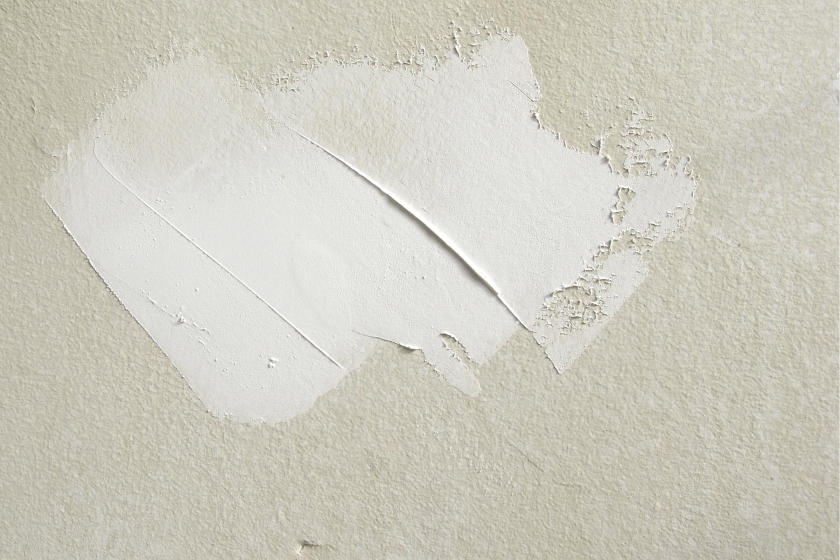Repairing holes and dings in walls with spackle and paint is one of the easiest home improvement projects you can undertake to vastly improve the look of your home’s interior. Keep reading to learn proper spackling technique so that you know how to do it easily and correctly every time.
Spackling School
Before you start, here’s a brief lesson on spackle. Spackling paste or spackling compound is made of gypsum powder and binders and is used to patch small holes, cracks and other imperfections like dents in drywall, plaster walls, and sometimes in wood. It comes in powdered (mixed with water before application) or paste form, the paste form being the most commonly used and known. Actually, the word Spackle® itself is a registered trademark but it is commonly used to describe spackling compound. It is also sometimes used, erroneously, in reference to drywall joint compound, which is similar but an altogether different product. Joint compound is mostly used to cover joints between wallboard panels and to cover the fasteners and screws used to attach wallboard to studs underneath. It can be used like spackle, but it is better for repairing larger holes and damage that require backing or other reinforcement.
Step 1: Prepare the Spackling Spot
Before applying spackle, you must clean and otherwise smooth out the area around the hole or crack so that the surface is optimized for proper spackling paste adhesion. Often, a hole in drywall, whether it’s caused by blunt force or by a screw, nail or other type of fastener, will have an outer edge or fragments that protrude outward. You want the area directly around the hole to be as smooth and even as the rest of the wall’s surface. Use a putty knife to gently scrape away loose paint and protruding fragments of wallboard until the surface around the hole is as smooth as the rest of the wall. Be careful not to make the hole or crack bigger. You’ll undoubtedly remove some paint sitting right around the hole, but since you’ll be painting over the spackling compound once it’s dried, don’t sweat it. Press the putty knife firmly against the wall at an angle and scrape up and down until the dust and debris stops falling.
Helpful Tips
Fine-grit sandpaper is good for smoothing down the surface around a hole if there are not too many fragments or a protruding outer edge. Just give it a couple of quick brushes with the sandpaper to smooth it down.
If you’re going to spackle over nails or screws that popped through your wall’s paint, use a nailset and hammer to push them in below the wall’s surface.
If you’re working on holes of 2″ or greater in diameter, you may need to purchase or make a wall-repair patch and apply it before using joint compound to seal it in place. See Patch and Repaint Walls.
After you have scraped or sanded the area, wipe it down with a damp cloth to remove any dust and residue.
Step 2: Apply Spackling Compound
Open the container of premixed spackling compound and scoop up a small amount of it with the edge of a putty knife. You won’t be slathering the compound on the damaged area, so you want just enough of it to fill in the hole or crack. Put the compound-covered blade of the putty knife at a 45-degree angle to the wall and spread the compound over the hole or crack in a smooth, feathering motion. Do this until the hole is completely filled in.
Helpful Tips
Consider using two putty knives — one with a wide blade and one with a narrow blade. Dip the wide knife into the can of spackling compound and use it as a palette. The narrow knife can be used to apply the compound to the damaged area on the wall. You can also scrape excess compound from the narrow knife onto the edge of the wide knife for a cleaner, more controlled application.
Always close the spackling compound lid after you’ve taken out what you need. It dries quickly and can be ruined if left exposed to the air.
Scrape away excess compound from the wall with your putty knife with the blade at a 90-degree angle to the wall. Take care that you don’t remove the spackle from the hole or crack when you remove the excess. Use a damp cloth to remove any compound adjacent to the patch that you didn’t remove by scraping. Do this quickly before the compound sets.
Let the patch dry completely – this usually takes a few hours. After it has dried, the spackle may have depressed slightly below the surface of the wall. If so, simply apply a small amount again over the hole and let it dry until the patch is even with the wall surface.
You will likely find, after the compound has dried, that you’ve applied a little too much spackle and the surface of the patch is slightly raised and not flush with the rest of the wall’s surface. Lightly sand it down with fine-grit sandpaper until it is even with the wall. Wipe away dust and debris caused by sanding with a damp cloth.
Step 3: Paint
Depending on how many holes or cracks you filled and covered with spackle, you may not need to repaint the entire wall. If the repaired area is only 2″ or so, you may be able to get away with dabbing some paint onto the patch with a sponge paintbrush, if you have leftover paint of the same color. If you patched spots in more than a few parts of the wall, or you can’t apply the exact same paint you used previously on the wall, it’s best to prime and paint the wall again. Otherwise, the patched spots will show on your wall’s surface.
Before starting to paint, remove furniture or place it in the center of the room and cover it with drop cloths. Place drop cloths on the floor and secure them with tape so that they don’t move around. Remove window coverings, switch plates and outlet covers. Use painter’s tape to protect windowsills, baseboards, door hinges and the ceiling perimeter.
Apply a quality primer with a large paintbrush or roller applicator, using the same technique you would as painting. Make sure you cover the entire surface of the wall.
Safety Alerts!
Open the windows to make sure you’ll be priming and painting in a well-ventilated area.
Pour True Value EasyCare Ultra Premium Interior Paint into a paint tray and coat your roller or paintbrush. Paint widthwise in 6-ft. square sections, using a zigzag pattern of overlapping W strokes. Move from right to left, then left to right, spreading evenly with vertical strokes.
To ensure even coverage, use light strokes to re-roll across the bottom to the top of each wall. If your paint has a flat finish, you don’t need to blend. Otherwise, to blend, paint over the entire surface (for very large areas, do two square sections at a time) with one-directional, overlapping, non-diagonal strokes once again.
Using a small, angular paintbrush, do wall brushwork in areas where your roller can’t reach, like the corners, and next to doors, windows and molding.
Thoroughly rinse your roller covers and brushes in water until the water runs clear. Store them in plastic bags or hang them on nails or hooks to dry. Remove drop cloths and pull off painter’s tape at a 45-degree angle to avoid removing any fresh paint.
That’s it! You’re done. With these tips, your walls should look good as new.
Project Shopping List
Here’s what you’ll need to complete this project successfully.
- Putty knife
- Fine-grit sandpaper
- Nail set
- Hammer
- Wall-repair patch kit
- Cloth
- Spackling compound
- Sponge paintbrush
- Drop cloths
- Screwdriver
- Painter’s tape (optional)
- EasyCare Ultra Premium Interior Primer/Sealer
- EasyCare Ultra Premium Interior Paint
- Paintbrushes
- Roller applicator
- Paint tray
- Small angular paintbrush
- Plastic bags












